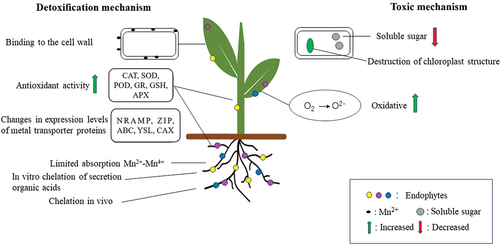Figures & data
Table 1. Host plants and their associated endophytes.
Figure 1. The mechanisms by which endophytes mediate increased plant resistance under heavy metal stress, salt stress, and high temperature stress. For example, under high temperature stress, endophytes enhance the expression of heat shock protein 90, activate protein kinases YDA, MKK, MPK, and affect the phosphorylation of SPCH to regulate stomatal size [Citation57]. Under heavy metal stress, the endophytes promoted the secretion of organic small molecules and extracellular polymers from the root system to bind heavy metals and limit the influx of heavy metals into the cells [Citation58]. Under salt stress, endophytes promote the secretion of ABA, which binds to the PYL/PP108 receptor and to the protein phosphatase PP2C to form the PYL-ABA-PP2C complex, ultimately reducing ROS [Citation59].
![Figure 1. The mechanisms by which endophytes mediate increased plant resistance under heavy metal stress, salt stress, and high temperature stress. For example, under high temperature stress, endophytes enhance the expression of heat shock protein 90, activate protein kinases YDA, MKK, MPK, and affect the phosphorylation of SPCH to regulate stomatal size [Citation57]. Under heavy metal stress, the endophytes promoted the secretion of organic small molecules and extracellular polymers from the root system to bind heavy metals and limit the influx of heavy metals into the cells [Citation58]. Under salt stress, endophytes promote the secretion of ABA, which binds to the PYL/PP108 receptor and to the protein phosphatase PP2C to form the PYL-ABA-PP2C complex, ultimately reducing ROS [Citation59].](/cms/asset/d864426d-90e7-44db-87d6-78bc2206f6a2/tcsb_a_2323123_f0001_oc.jpg)
Figure 2. Pathways to improve plant tolerance to Cd through the endophytic fungi, arbuscular mycorrhizal fungi (AMF). Plant extracellular Cd-restriction -and intracellular Cd-accumulation to optimize their distribution. Extracellularly, AMF anchors Cd to the plant root and reduces the transfer of Cd to the shoot by increasing the polysaccharide content in the cell wall and thus improving its ability to bind Cd. Inside the cell, AMF enhances the synthesis of plant chelatins (PCs) by glutathione (GSH), allowing more Cd to form PCs-Cd complexes with PCs and be stored in organelles such as vacuoles. The top left illustrates plants that were not inoculated with endophytes, yet these endophytes exhibited a notable enhancement of plant growth in Cd compared to their inoculated counterparts. These endophytes are composed of endophytes (pink), endophytic bacteria (blue), and endophytic actinomycetes (yellow). Adapted from [Citation69].
![Figure 2. Pathways to improve plant tolerance to Cd through the endophytic fungi, arbuscular mycorrhizal fungi (AMF). Plant extracellular Cd-restriction -and intracellular Cd-accumulation to optimize their distribution. Extracellularly, AMF anchors Cd to the plant root and reduces the transfer of Cd to the shoot by increasing the polysaccharide content in the cell wall and thus improving its ability to bind Cd. Inside the cell, AMF enhances the synthesis of plant chelatins (PCs) by glutathione (GSH), allowing more Cd to form PCs-Cd complexes with PCs and be stored in organelles such as vacuoles. The top left illustrates plants that were not inoculated with endophytes, yet these endophytes exhibited a notable enhancement of plant growth in Cd compared to their inoculated counterparts. These endophytes are composed of endophytes (pink), endophytic bacteria (blue), and endophytic actinomycetes (yellow). Adapted from [Citation69].](/cms/asset/1e46c47c-ccdc-4d77-85e3-c17c9c7f65d1/tcsb_a_2323123_f0002_oc.jpg)
Figure 3. Toxic effects of manganese on plants and detoxification mechanisms of endophytes in response to manganese stress. Manganese stress harms plants by reducing soluble sugars, destroying chloroplast structure, producing excessive reactive oxygen species, and inhibiting root growth. Endophytes help plants alleviate Mn stress mainly by limiting Mn attachment to cell walls, regulating antioxidant system of plants and the transport of their metal transporter proteins, restricting the uptake of Mn ions by roots, and secreting organic acids for chelating in vitro.

Table 2. Effect of plant endophytes on salinity stress.
Table 3. Role of endophytes in alleviating heat stress (↑: increase traits, ↓: decrease traits).
Table 4. Role of endophytes in host plants under other abiotic stresses (↑: increase traits, ↓: decrease traits).
Table 5. The effects of endophytes on the resistance to the pathogens.
Table 6. Role of secondary metabolites of endophytes.
